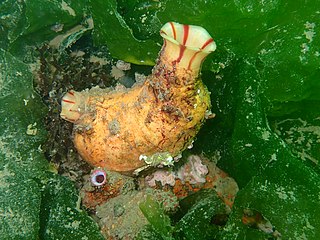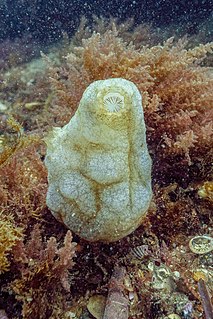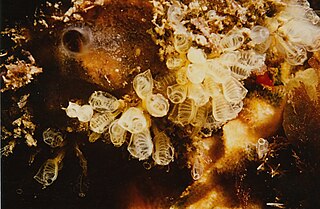
Ascidia is a genus of tunicates in the family Ascidiidae.
Sorberacea were a monoorder and monofamilial class of benthic Tunicates. The single order of the class was Aspiraculata, and the single family of that order was Hexacrobylidae. In a taxonomic revision of the Tunicata in 2007, the name "Hexacrobylidae" was declared invalid and members of the family were included in the family Molgulidae in the class Ascidiacea.

Clavelinidae is a family of tunicates in the order Enterogona. It describes a group of marine animals.

Molgula, or sea grapes, are very common, globular, individual marine tunicates roughly the size of grapes.

Clavelina is genus of sea squirts, containing the following species:

Phlebobranchia is a suborder of sea squirts in the class Ascidiacea.

Pyuridae is a family of tunicates.

Stolidobranchia is an order of tunicates in the class Ascidiacea. The group includes both colonial and solitary animals. They are distinguished from other tunicates by the presence of folded pharyngeal baskets. This provides the etymology of their name: in ancient Greek, στολίς, ίδος means the "fold" of a cloth. Stolidobranchian sea squirts are also characterized by the complete absence of an abdomen. The abdominal organs of other tunicates are instead located to one side of the pharyngeal basket in this group.

Aplousobranchia is an order of sea squirts in the class Ascidiacea. They are colonial animals, and are distinguished from other sea squirts by the presence of relatively simple pharyngeal baskets. This provides the etymology of their name: in ancient greek, ἁ.πλοος-ους (ha.ploos-ous) means "simple". The posterior part of the abdomen contains the heart and gonads, and is typically larger than in other sea squirts.

Pycnoclavella diminuta, known as the white-spotted sea squirt, white-spot ascidian, and white-spotted ascidian, is a species of tunicate, in the genus Pycnoclavella. Like all ascidians, these sessile animals are filter feeders.

Phallusia is a genus of tunicates of the family ascidians, which includes the following species:

Perophora is a sea squirt genus in the family Perophoridae. Most species are found in shallow warm water but a few are found in higher latitudes. A colony consists of a number of zooids which bud off from a long slender stolon.
Patricia Mather was an Australian zoologist and taxonomist known for her research into sea squirts. She became a leader in Australian marine science and internationally achieved status through her work on the Ascidiacea. She has published more than 150 papers including her major monograph on the "Australian Ascidiacea".

Molgulidae is a family of tunicates in the class Ascidiacea. Following a revision in 2007, the family Hexacrobylidae was synonymized with Molgulidae.

Metandrocarpa is a genus of ascidian tunicates in the family Styelidae.
Stolonica is a genus of ascidian tunicates in the family Styelidae.

Symplegma is a genus of ascidian tunicates in the family Styelidae.
Claudenus is a genus of ascidian tunicates in the family Pyuridae.
Ctenyura is a genus of ascidian tunicates in the family Pyuridae.

Pycnoclavella is a genus of sea squirts first circumscribed by Walter Garstang in 1891. The generic name comes from the Ancient Greek πυκνός (puknós) meaning "closely united". In 1990, Patricia Kott placed Pycnoclavella in its own family, Pycnoclavellidae, but in 2008 it was moved back to Clavelinidae.












